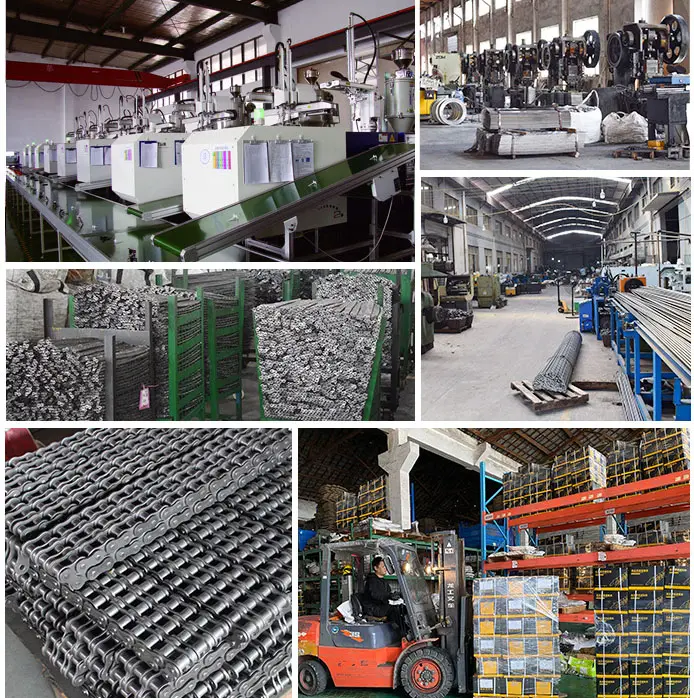To comprehensively explore the standard pitch for a roller chain, it is crucial to delve into the fundamentals of roller chains, their application, how pitch is measured, the various types of pitches, and standards governing them.
Understanding Roller Chains
Roller chains are a type of chain drive widely used in a variety of mechanical applications. They consist of a series of short cylindrical rollers held together by side links. These chains engage with the teeth of a sprocket gear, thus transferring power in machinery.

The Concept of Pitch in Roller Chains
The pitch of a roller chain is a key dimension; it is the distance between the centers of the pins in the chain. The pitch is critical because it must match the pitch of the sprockets with which the chain engages. If the pitches are mismatched, the chain will not fit the sprocket properly, leading to wear and potential failure.
Measurement of Pitch
The pitch is usually measured in inches or millimeters. It is calculated from the center of one pin to the center of the next pin in the chain. This measurement is crucial for the proper sizing and selection of roller chains for specific applications.
Standard Pitches in Roller Chains
There are several standard pitches for roller chains, which have been established to ensure compatibility and interchangeability across various machines and applications. These standard pitches are governed by standards organizations such as the American National Standards Institute (ANSI) and the International Organization for Standardization (ISO).
ANSI Standard Pitches
In the United States, the ANSI standard is widely followed. The ANSI standardizes roller chain pitches in fractional inches. Common pitches under ANSI standards include 1/4 inch, 3/8 inch, 1/2 inch, 5/8 inch, 3/4 inch, and 1 inch, among others. Each of these sizes corresponds to a specific chain size, with the chain size number being 8 times the pitch in inches. For example, a chain with a 1/2 inch pitch is an ANSI #40 chain.
ISO Standard Pitches
Internationally, ISO standards are prevalent. ISO standard pitches are usually given in millimeters. Some common ISO standard pitches include 6 mm, 8 mm, 12.7 mm (which is very close to the 1/2 inch ANSI standard), and 15.875 mm. The ISO designations are typically a metric equivalent or close approximation of the ANSI standards.
Factors Affecting the Choice of Pitch
The selection of a pitch for a roller chain in a particular application depends on several factors:
- Load Requirement: Heavier loads require chains with larger pitches, which have greater load-bearing capacity.
- Speed of Operation: Higher speeds may require a finer pitch for smoother operation.
- Space Constraints: In compact mechanisms, a smaller pitch might be necessary due to space limitations.
- Compatibility with Existing Equipment: When replacing or integrating with existing machinery, the pitch must match the existing system.

Importance of Standard Pitch
The standardization of pitch in roller chains is crucial for several reasons:
- Interchangeability: Standard pitches allow for the interchangeability of chains and sprockets across different equipment and manufacturers.
- Ease of Replacement: It simplifies the process of replacing worn or damaged chains.
- Predictability in Performance: Standard pitches ensure predictable performance characteristics of chains in various applications.
Non-Standard Pitches
While standard pitches cover most applications, there are instances where non-standard pitches are used. These are typically in specialized or custom equipment where specific requirements necessitate a unique pitch.
Maintenance and Wear
The longevity and efficiency of a roller chain are greatly affected by proper maintenance. Over time, chains can elongate due to wear, which can alter the effective pitch. This wear can lead to misalignment with the sprocket, reduced efficiency, and potential failure.
The standard pitch for a roller chain is a fundamental aspect of its design and application in mechanical systems. The standard pitches as set by ANSI and ISO cover a broad range of applications, ensuring compatibility and efficiency in power transmission. Understanding the pitch is crucial for the correct selection, maintenance, and operation of roller chains in various industrial and mechanical applications. This standardization not only facilitates ease of use and replacement but also ensures the reliability and longevity of the machinery in which these chains are used. As technology evolves, the standards for pitches may adapt, but the core concept of pitch as a critical dimension in roller chains will remain a cornerstone of mechanical design and engineering.